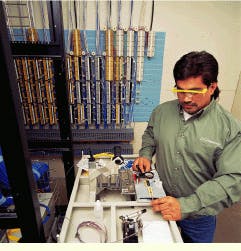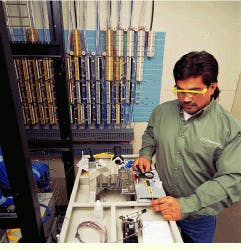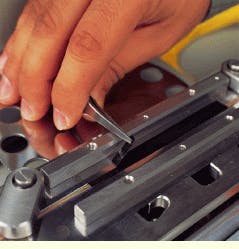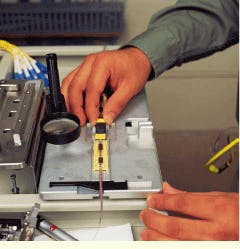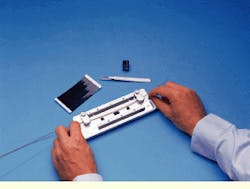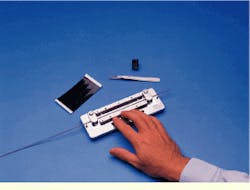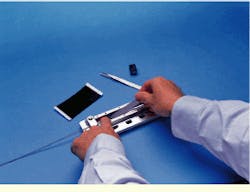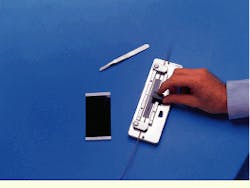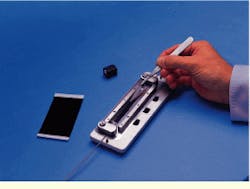Mass mechanical splicing offers low cost and quick transitions.
Richard Domalski / 3M Telecom Systems Div.
Large splicing jobs are a way of life in the traditional outside-plant environment. However, customer-owned premises cabling and fiber-optic backbone cabling provide new challenges for fiber splicing and for connectorizing multifiber cables, especially when a large number of connectors are needed where fiber meets active equipment. Mass mechanical splicing is a procedure that saves time and lowers labor costs when this infrequent need does arise.
Until recently, installers mainly used 250-micron singlemode fiber in the customer-owned outside plant. The fiber ran from the point where the cable entered the premises to where it was terminated at the equipment room. Today, 250-micron singlemode fiber--and increasingly 250-micron multimode fiber--is making its way into horizontal cabling runs and throughout the campus environment. Typically found in loose-tube cable configurations, 250-micron fiber--which takes up less space in cable duct and is easier to pull than 3-millimeter jacketed fiber cable--is now commonly used in air-blown fiber systems and with some of the newer fiber-to-the-desk cabling systems, such as the new Volition Cabling System from 3M Telecom Systems Div.
While the use of 250-micron fiber is increasing in the United States, the need to ribbonize loose-tube fibers and to perform multifiber splices is also growing at transition points in the premises. Meanwhile, the Asia-Pacific region is now widely using these splices for premises cabling. In China and India, which are among the world`s largest markets for 250-micron ribbon fiber in the customer-owned premises, installers commonly use mass mechanical splicing in the installation of new fiber networks.
The need to terminate large numbers of fibers is most often found between buildings on a campus, at the point where outside-plant fiber enters a building, and at the transition point from backbone fiber to horizontal cabling within buildings. Because the number of fibers being connectorized in premises applications is growing, it is worth investigating the time-saving potential of ribbonizing fibers, using multifiber mechanical splicing, and installing factory-terminated pigtails for high- performance connections.
Ribbonizing multiple fibers
Since mass mechanical splicing is designed to be used with ribbon or ribbonized fiber cable, it is first necessary to construct ribbons out of loose-tube 250-micron fibers. You can construct ribbonized fiber in a few simple steps by using a ribbon construction tool kit (see "Ribbonizing for quicker splicing," page 18). Ribbonizing 250-micron fiber using a kit is inexpensive and adds the flexibility of combining fibers in counts of 4, 6, 8, 10, and 12. After ribbonizing the fibers, you can proceed to mass mechanical splicing before installing pigtails or before transitioning from outside-plant fiber to indoor fiber where the cable enters a building.
Multifiber mechanical splicing
Multifiber mechanical splices can be reliable, quick to install, and inexpensive. They are most commonly used where a cable comes in from outdoors before being routed to a concentrator or before fibers are split off from a cable when they are rerouted. The process is also an efficient solution for terminating a large number of fibers to active equipment.
Multifiber mechanical splices offer flexibility in changing out equipment at the point where the outside-plant fiber transitions to a patch panel. This flexibility is important because the National Electrical Code requires installers to transition outside-plant cable into riser- or plenum-rated premises fiber cable within 50 feet of entering a building.
Using mass mechanical splicing techniques and factory- terminated pigtails takes less time and yields a better-performing circuit than making discrete fiber splices and polishing individual connectors. More important, mass mechanical splicing and factory-terminated pigtails offer an inexpensive, readily available option for technical crews that neither have nor necessarily need a fusion splicer or other connector terminating equipment.
With mass mechanical splices, you can splice up to 12 fibers in less than five minutes with a higher level of craft-friendliness than is possible when connectorizing. You can splice 48 loose-tube ribbonized fibers per hour using multifiber mechanical splices, compared to only 36 fibers per hour using a mass fusion splicer. Mass mechanical splicing cuts splicing costs in half on big jobs; the per-fiber cost of one mass mechanical splice is 50% less than that of a discrete mechanical splice.
Repositionable splices
Repositionable multifiber mechanical splices, such as the Fibrlok brand 2600 series multifiber splice from 3M, are also available; they do not require installers to cut out the splice when replacing it, which is necessary when using mass fusion splicing. By simply releasing the clamping wedge on the splice, it is possible to reposition the fibers and then retest the joint to ensure low insertion loss. Average insertion loss for this particular mechanical multifiber splice is less than 0.1 decibel. Visually inspecting the cleave before splicing is critical to high performance; a good cleave is one of the most important factors in ensuring a high-performance splice.
Pigtails
Splicing multiple fibers onto factory-terminated pigtails, which consist of an unterminated fiber at one end and a connector at the other end, offers far lower insertion loss than an installer can attain when terminating pigtails in the field. For example, while a factory-terminated pigtail could test at -55 dB, a good technician would normally achieve only about -40 dB in the field using traditional on-site polishing methods. Pigtails with high-performance finishes, such as angle polish, are ideal for use where high performance is critical, such as in a campuswide video network. Equivalent performance cannot be accomplished manually in the field. Pigtails are priced from $10 to $50 per connector, and they do not have to be terminated in the field. Their use also results in lower labor costs.
For more than a decade, the mass mechanical splice has proven its high performance in traditional telephony, and now savvy cable installers are finding practical uses for it in premises jobs. By rethinking the traditional application of the mass mechanical splice and applying it at points in the network where it can do the job faster and better than discrete splicing or termination, installers can attain a new level of performance while saving time and money.
Edward Guajardo, a senior technician with SabreData (Austin, TX), splices the end of a fiber-optic pigtail using a 3M Fibrlok 2612 Multifiber Optical Splice.
When you are working with 250-micron fiber, it is necessary to construct ribbons out of loose-tube fibers before mass mech-anical splicing can take place. Here the technician is using a Fibrlok brand 2670 Multifiber Ribbon Construction Tool to rib-bonize a fiber before mechanical splicing.
Using a multifiber mechanical splice to install factory-terminated pigtails is a time-saving method for obtaining a high-performance connection.
Ribbonizing for quicker splicing
When you are faced with terminating large numbers of 250-micron fibers as they enter a building or with connecting fibers to active equipment, ribbonizing can provide a fast, low-cost solution. Ribbonizing, by turning loose-tube fiber cable into multifiber cable of 4 to 12 fibers in a few simple steps, speeds the splicing process and makes it easier to transition to the patch panel or install factory-terminated pigtails.
Ribbonizing kits for mechanical splicing are relatively inexpensive, costing about $400. With a few simple tools, installers can ribbonize a 12-fiber, 250-micron cable in two to three minutes and then mass mechanical splice the fiber in less than five minutes.
Ribbonizing steps
Step 1: Remove the cable sheath and buffer tube from the fiber and carefully clean the gel from the fiber strands. Place the fibers in color-coded order in the ribbon construction tool. Trim the fiber ends so they extend 2 to 3 inches beyond the tool, and place the ends of the fibers within a 1/2 inch of each other. Insert the fibers under the swing-out arms of the tool and smooth them flat with your fingertip.
Step 2: Slowly slide the packing shim against the fibers, being careful not to overpack them. Run your finger over the fibers to smooth them down and ensure that the fibers are not crossed. Grasp the fibers and pull them back, aligning the fiber ends within a 1/2 inch of the tool`s edge. Clean the tops of the fibers with alcohol and a lint-free cloth.
Step 3: Remove the peel-off liner from the back of the ribbonizing tape and carefully position it so the ends line up within the square notches inside the ribbonizing tool. Press the tape onto the fibers by running your finger over the top and applying pressure.
Step 4: To trim off excess tape, align the blade on the front guide rail and apply pressure as you slide the blade along the rail. Repeat this process for the rear rail and remove the excess tape using tweezers.
Step 5: To remove the ribbonized fiber, run your finger along the tape once again to ensure good adhesion. While holding the ribbon, slide the packing shim back and swing the arms outward and slowly lift up the ribbon. Snip the ends of the fiber to about a 1/2 inch from the tape in preparation for splicing.
Richard Domalski, registered communications distribution designer (rcdd), is a senior applications engineer for the 3M Telecom Systems Div. (Austin, TX).
